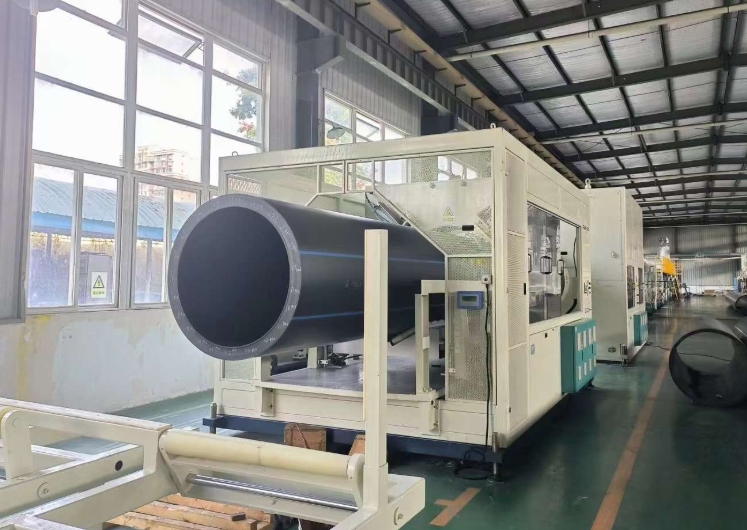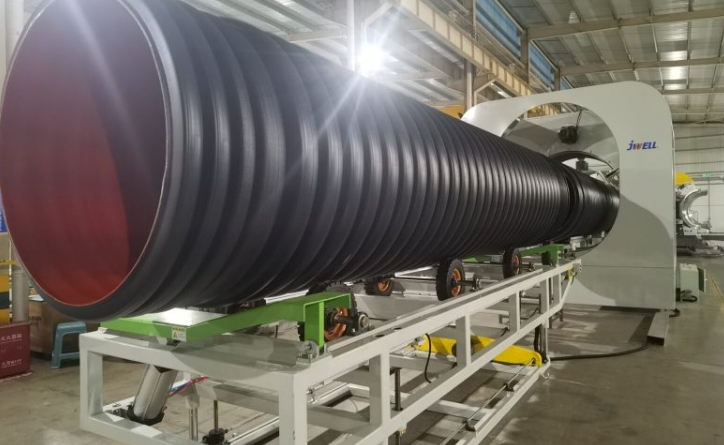Content Menu
● Understanding Used Pipe Extrusion Equipment
>> Key Components of Pipe Extrusion Equipment
● Types of Pipe Extrusion Machines
● Critical Factors When Choosing Used Pipe Extrusion Equipment
>> 1. Material Compatibility
>> 2. Production Capacity and Output
>> 3. Pipe Specifications
>> 4. Condition and Age of Equipment
>> 5. Control Systems and Automation
>> 6. Energy Efficiency
>> 7. Maintenance and Spare Parts Availability
>> 8. Cost and Return on Investment
● Step-by-Step Guide to Selecting Used Pipe Extrusion Equipment
>> Step 1: Define Your Production Needs
>> Step 2: Research Suitable Machine Types
>> Step 3: Evaluate Machine Specifications
>> Step 4: Inspect and Test the Equipment
>> Step 5: Assess Support and Spare Parts
>> Step 6: Analyze Total Cost
>> Step 7: Negotiate and Document the Purchase
● Common Pitfalls to Avoid
● Maximizing Value from Used Pipe Extrusion Equipment
● Conclusion
● FAQ
>> 1. What are the most important factors to check when inspecting used pipe extrusion equipment?
>> 2. How do I determine if a single-screw or twin-screw extruder is better for my application?
>> 3. Is it possible to upgrade used pipe extrusion equipment with modern controls?
>> 4. What are the typical maintenance needs for used pipe extrusion equipment?
>> 5. How do I ensure spare parts availability for older used pipe extrusion machines?
Selecting the right used pipe extrusion equipment is a critical decision for any manufacturer aiming to balance cost, performance, and long-term reliability. The right choice can elevate your production efficiency, reduce operational costs, and ensure consistent product quality. However, the process is complex, involving technical, financial, and operational considerations. This comprehensive guide will walk you through every essential aspect of choosing the best used pipe extrusion machine for your specific requirements.

Understanding Used Pipe Extrusion Equipment
Pipe extrusion equipment is designed to melt raw plastic materials and shape them into continuous pipe profiles through a die. The process includes feeding, melting, shaping, cooling, sizing, and cutting. Used pipe extrusion equipment refers to previously owned machines that are resold for continued use, often offering substantial savings over new models while still delivering reliable performance if properly selected and maintained.
Key Components of Pipe Extrusion Equipment
- Extruder (Screw and Barrel): The heart of the system, responsible for melting and conveying material.
- Die Head: Shapes the molten plastic into the desired pipe profile.
- Cooling System: Solidifies the pipe to maintain its shape.
- Haul-Off Unit: Pulls the pipe at a controlled speed.
- Cutter or Winder: Cuts the pipe to length or winds it for storage.
Types of Pipe Extrusion Machines
Choosing the right type of used pipe extrusion equipment depends on your production needs and the materials you intend to process.
| Type | Best Suited For | Material Compatibility | Advantages |
| Single-Screw Extruder | Simple pipe production | PVC, HDPE | Easy operation, cost-effective |
| Twin-Screw Extruder | Complex materials, thorough mixing | PVC, PP, specialty blends | Better mixing, versatile |
| Co-Extrusion Machine | Multi-layered pipes | Multiple materials | Enhanced pipe properties |
| Custom Extrusion | Specialized applications | Depends on design | Tailored to unique requirements |
Critical Factors When Choosing Used Pipe Extrusion Equipment
1. Material Compatibility
Ensure the used pipe extrusion equipment can handle the materials you plan to process, such as PVC, HDPE, PP, or specialty blends. Different polymers require specific screw designs, temperature controls, and die configurations.
2. Production Capacity and Output
Assess the machine's throughput-how much material it can process per hour. This is influenced by the screw diameter, length, and design. Larger screws generally allow higher output, but require more power and robust drive systems.
3. Pipe Specifications
Match the machine's capabilities with your required pipe dimensions, wall thickness, and tolerances. The die must be suitable for your product specifications, and the cooling and sizing systems must accommodate your pipe sizes.
4. Condition and Age of Equipment
Inspect the physical and operational condition of the used pipe extrusion equipment. Check the wear on screws, barrels, and gearboxes, as these are subject to significant mechanical and thermal stress. Reliable brands and high-quality components extend machine life and ease maintenance.
5. Control Systems and Automation
Modern control systems improve process consistency and efficiency. Look for advanced controls that allow precise management of temperature, speed, and pressure, as well as features like auto screen changers and gravimetric feeders for consistent material input.
6. Energy Efficiency
Energy costs are a major operational expense. Opt for used pipe extrusion equipment with efficient motors, heating, and cooling systems. Advanced models may offer variable speed drives and optimized heating zones to reduce consumption.
7. Maintenance and Spare Parts Availability
Availability of spare parts and technical support is crucial for minimizing downtime. Choose equipment from reputable manufacturers with a track record of reliability and accessible service networks.
8. Cost and Return on Investment
While used equipment is more affordable upfront, consider the total cost of ownership, including repairs, upgrades, and operational efficiency. A bargain machine may require significant investment to restore or adapt to your needs.

Step-by-Step Guide to Selecting Used Pipe Extrusion Equipment
Step 1: Define Your Production Needs
- What materials will you process?
- What are your target pipe sizes, wall thicknesses, and tolerances?
- What is your required output (kg/hr or m/hr)?
Step 2: Research Suitable Machine Types
- Single-screw for straightforward jobs and common materials.
- Twin-screw or co-extrusion for complex blends or multi-layer pipes.
Step 3: Evaluate Machine Specifications
- Check screw diameter, length, and L/D ratio for throughput and mixing.
- Confirm die compatibility with your product requirements.
- Assess the condition of key components (screw, barrel, gearbox, controls).
Step 4: Inspect and Test the Equipment
- Physically inspect the machine if possible.
- Request operational demonstrations or test runs.
- Review maintenance records and previous usage history.
Step 5: Assess Support and Spare Parts
- Ensure the manufacturer or dealer offers technical support.
- Verify the availability and cost of spare parts.
Step 6: Analyze Total Cost
- Compare the used equipment price to new models.
- Factor in repair, upgrade, shipping, and installation costs.
- Estimate return on investment based on expected output and efficiency.
Step 7: Negotiate and Document the Purchase
- Work with reputable dealers or sellers.
- Get all terms, specifications, and warranties in writing.
- Arrange for secure shipping and installation support.
Common Pitfalls to Avoid
- Overlooking hidden wear: Failing to inspect screws, barrels, and gearboxes can lead to costly repairs.
- Ignoring control systems: Outdated or malfunctioning controls can compromise product quality and efficiency.
- Underestimating installation costs: Moving and setting up used pipe extrusion equipment can be complex and expensive.
- Buying on price alone: The cheapest option may require significant investment to restore or adapt to your needs.
Maximizing Value from Used Pipe Extrusion Equipment
- Prioritize reputable brands and well-maintained machines.
- Seek equipment with modern controls and energy-saving features.
- Negotiate for spare parts or service agreements.
- Regularly maintain and upgrade critical components to extend machine life.
Conclusion
Choosing the right used pipe extrusion equipment is a strategic investment that requires careful evaluation of your production needs, machine specifications, operational condition, and support infrastructure. By following a structured approach-defining requirements, researching options, inspecting equipment, and considering long-term costs-you can secure reliable, cost-effective machinery that boosts your manufacturing capabilities. Remember, the best value comes not just from the lowest price, but from equipment that delivers consistent performance, efficiency, and adaptability for years to come.

FAQ
1. What are the most important factors to check when inspecting used pipe extrusion equipment?
When inspecting used pipe extrusion equipment, focus on the condition of the screw, barrel, gearbox, and die. Check for wear, corrosion, or misalignment. Evaluate the control systems, heating and cooling efficiency, and overall maintenance history to ensure reliable operation.
2. How do I determine if a single-screw or twin-screw extruder is better for my application?
Single-screw extruders are ideal for simple pipe production using standard materials like PVC or HDPE. Twin-screw extruders provide better mixing and are suited for complex blends, specialty polymers, or multi-layer pipes. Choose based on your material requirements and desired product complexity.
3. Is it possible to upgrade used pipe extrusion equipment with modern controls?
Yes, many used pipe extrusion machines can be retrofitted with modern control systems, variable speed drives, and improved heating/cooling elements. This can enhance efficiency, product quality, and ease of operation, but should be factored into your total investment.
4. What are the typical maintenance needs for used pipe extrusion equipment?
Regular cleaning, lubrication, and inspection of screws, barrels, and die heads are essential. Replace worn parts promptly and schedule professional servicing to address technical issues. Keeping detailed maintenance records helps extend equipment lifespan and prevent unexpected downtime.
5. How do I ensure spare parts availability for older used pipe extrusion machines?
Choose equipment from well-known brands with established service networks. Before purchase, confirm the availability and cost of critical spare parts, such as screws, barrels, heaters, and control modules. Some older machines may require custom fabrication of replacement parts.






















